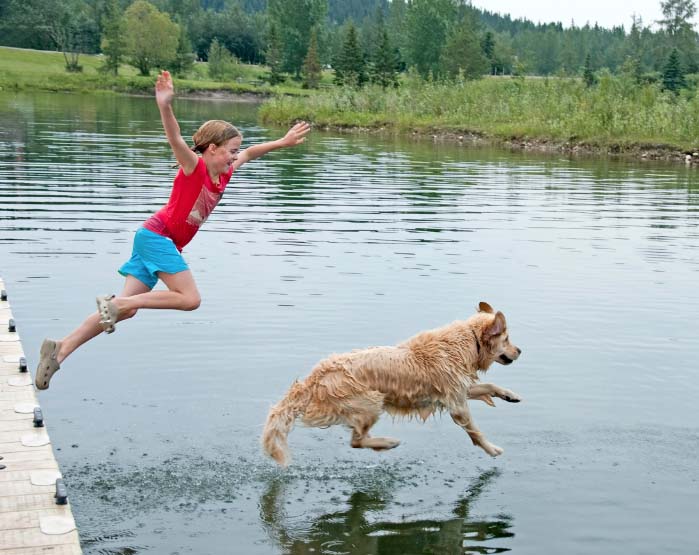Summer provides a great opportunity to exercise your dog outdoors more often, so here are a few simple summertime pet tips to help keep your pet safe and healthy as the temperatures start to rise.
- Exercise your dog at the times of day when the temperatures are the coolest, to help avoid dehydration. Getting out first thing in the morning or later at night, after the sun has gone down, are most often the best times of day in the summer to walk your dog and are often the healthiest times of the day for you to get your exercise too.
- Swimming is great exercise for your dog and it’s a great substitute for a walk, especially on days when the temperatures or pavement are just too darn hot to even consider walking your dog. And keep in mind that hot air temperatures and high humidity are not the only concerns, but also the surfaces your dog walks on (like cement and asphalt) can also be dangerous to the tender pads on their feet, which are used not just for walking, but they also provide an essential means for releasing heat from their bodies.
- Portable kiddie swimming pools can be a fun and creative way to cool your dog down and it’s a great activity to get the whole family involved too. Or, if you have one of those old twirly style sprinklers, they can be a fun way to keep your dog’s coat cooled down and many dogs enjoy the challenge of trying to drink from an oscillating sprinkler too, so it can also be entertaining just watching them attempt to!
- Use a portable spray bottle to spray and wet your dog down, or use a wet towel to cool down his overall body temperature or just let him lie on top of the wet towel. It helps if you keep in mind that dogs cool down from the bottom up, so don’t forget to spray your dogs belly and feet, in addition to spraying down the top of their back.
- Never leave your dog locked and unattended inside a parked car, since the heat inside a car can build up very quickly and put your dog at a very serious health risk, even if your car is parked in the shade. If you are traveling with your dog in the car, make sure to make periodic stops to walk him and give him moderate amounts of fresh water along the way.
- Fleas, ticks and heartworm disease are often more prevalent problems during the summer months and you should ask your veterinarian how to keep these conditions under control for your particular pet’s situation and environment.
- Know the basic signs of pet dehydration or talk to your vet about what signs or symptoms to look for if you suspect your dog might be dehydrated. Panting is part of the normal way your dog cools himself, but if your dog seems to be panting or drooling excessively, if he looks lethargic or his eyes appear bloodshot or pale, these can often be some of the basic symptoms of dehydration. Another test for dehydration is to pinch and lift up the skin on your dogs back and see how quickly it falls back into place, or you can also ask your vet to demonstrate how to use this quick skin test and what to look for.
So don’t be afraid to exercise your dog this summer, just keep in mind some of these basic summer activity guidelines to help avoid pet dehydration. And if your pet has additional special health conditions, always be sure to consult your veterinarian for professional advice to insure that everyone has a safe and healthy summer.








